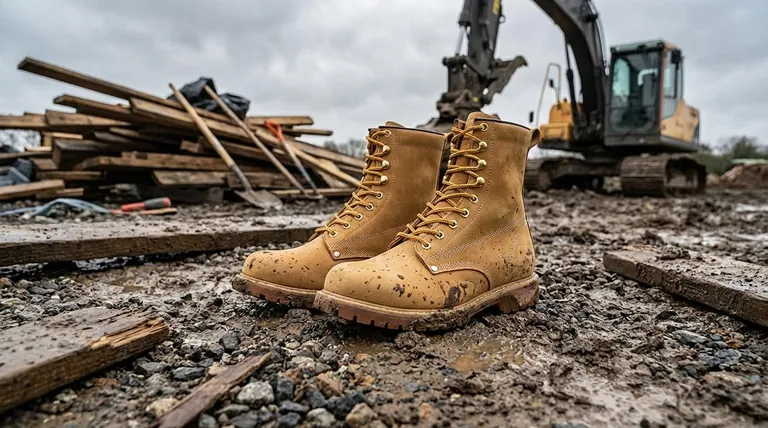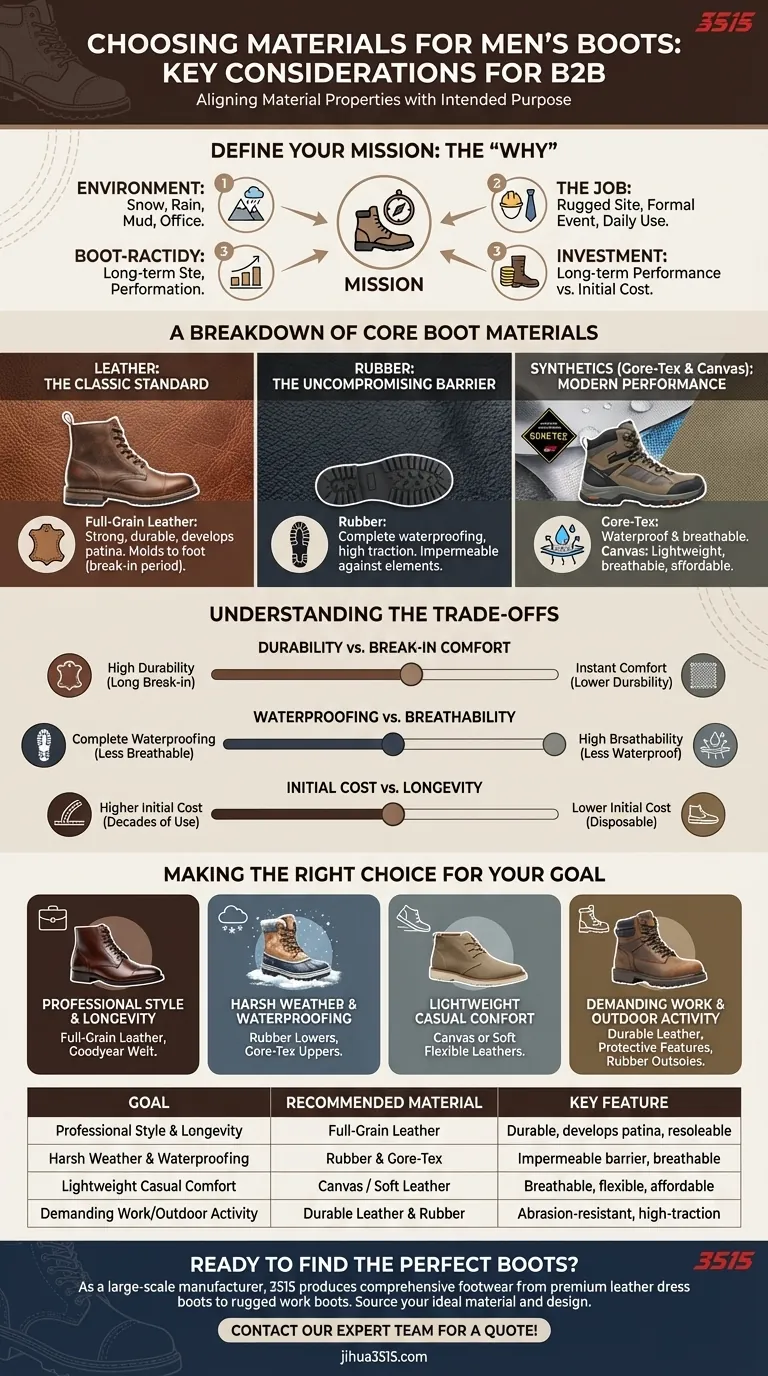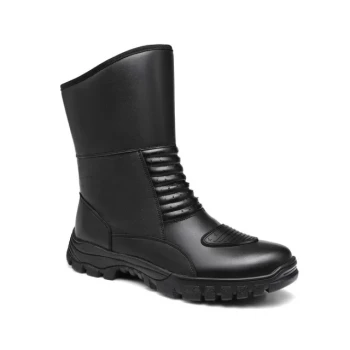The most critical consideration when choosing materials for men's boots is aligning the material's inherent properties with the boot's intended purpose. Your choice is a direct trade-off between durability, comfort, weather resistance, and style. The right material for a rugged hiking boot is fundamentally different from that of a refined dress boot, and understanding this context is the key to making a sound investment.
The central takeaway is this: Stop searching for the "best" material in a vacuum. Instead, define the primary job your boots need to perform. The material is not the goal; it is the tool selected to achieve a specific function, whether that's navigating a blizzard, commanding a boardroom, or hiking a trail.

Define Your Mission: The "Why" Behind Your Boots
Before comparing leather to rubber, you must first clarify the role these boots will play. A boot's material requirements are dictated entirely by its expected use and environment.
The Environment Dictates the Need
The conditions you face are non-negotiable. A material that excels in a dry, urban setting will fail in a wet, rural one. Will you be dealing with snow, rain, mud, or polished office floors?
The Job to Be Done
The activity is just as important as the environment. Boots for a construction site require abrasion resistance and safety features, while boots for a formal event prioritize a sleek aesthetic and a polished finish.
Investment vs. Accessory
High-quality materials represent an investment in long-term performance and comfort. Premium materials like full-grain leather mold to your foot and can last for years with proper care, making them more cost-effective over time despite a higher initial price.
A Breakdown of Core Boot Materials
Each material offers a unique profile of strengths and weaknesses. Understanding these profiles allows you to match the material to your mission.
Leather: The Classic Standard
Full-grain leather is the gold standard for durable, long-lasting boots. It is the strongest and most water-resistant type of leather, and it develops a unique patina over time. It requires a break-in period but molds to your foot for a custom fit.
Rubber: The Uncompromising Barrier
Rubber is the obvious choice for complete waterproofing and high-traction soles. It is essential for serious rain boots or the lower portions of winter boots. Its primary function is to create an impermeable barrier against the elements.
Synthetics (Gore-Tex & Canvas): Modern Performance
Modern synthetic materials offer specialized performance. Gore-Tex is a membrane prized for being both waterproof and breathable, preventing water from getting in while letting sweat vapor out. Canvas is a lightweight, breathable, and affordable option ideal for casual, fair-weather boots.
Understanding the Trade-offs
There is no perfect, all-purpose material. Every choice involves a compromise. Recognizing these trade-offs is the mark of an informed buyer.
Durability vs. Break-in Comfort
The most durable materials, like thick full-grain leather, often require a significant break-in period. Softer materials may feel comfortable out of the box but will not withstand the same level of abuse.
Waterproofing vs. Breathability
A truly waterproof material like rubber is not breathable, which can lead to sweaty, uncomfortable feet. A material like Gore-Tex attempts to solve this, but it is a complex balance. Untreated leather or canvas offers excellent breathability but minimal water resistance.
Initial Cost vs. Longevity
The most durable construction methods, such as a Goodyear welt, significantly increase a boot's price. However, this method allows the boot to be resoled multiple times, extending its life for decades. Cheaper, cemented constructions cannot be repaired, making the boot disposable once the sole wears out.
Making the Right Choice for Your Goal
With a clear understanding of your needs and the available materials, you can select the right boot with confidence. Use your primary goal as your guide.
- If your primary focus is professional style and longevity: Choose full-grain leather boots with a Goodyear welt construction that can be resoled.
- If your primary focus is harsh weather and waterproofing: Prioritize boots with rubber lowers and a waterproof, breathable membrane like Gore-Tex in the uppers.
- If your primary focus is lightweight comfort for casual use: Consider boots made from canvas or softer, more flexible leathers with a comfortable sole.
- If your primary focus is demanding work or outdoor activity: Look for a combination of durable leather, protective features, and high-traction rubber outsoles.
Choosing the right material transforms a boot from a simple purchase into a reliable, long-term tool tailored to your needs.
Summary Table:
| Goal | Recommended Material | Key Feature |
|---|---|---|
| Professional Style & Longevity | Full-Grain Leather | Durable, develops patina, can be resoled |
| Harsh Weather & Waterproofing | Rubber & Gore-Tex | Impermeable barrier, breathable |
| Lightweight Casual Comfort | Canvas / Soft Leather | Breathable, flexible, affordable |
| Demanding Work/Outdoor Activity | Durable Leather & Rubber | Abrasion-resistant, high-traction soles |
Ready to find the perfect boots for your needs?
As a large-scale manufacturer, 3515 produces a comprehensive range of footwear for distributors, brand owners, and bulk clients. Our production capabilities encompass all types of men's boots—from durable work boots with premium leather and rubber soles to stylish dress boots with Goodyear welt construction. We can help you source or develop the ideal boot material and design for your target market.
Contact our expert team today to discuss your requirements and get a quote!
Visual Guide

Related Products
- Durable Goodyear Welt Leather Work Boots for Wholesale & Private Label
- Durable Leather Work Boots Wholesale Manufacturer & Custom Factory
- Durable Leather High-Ankle Tactical Boots for Wholesale & Custom Manufacturing
- Durable Leather Tactical Boots Wholesale & Custom Manufacturing for Brands
- Durable Leather Work Boots for Wholesale & Custom OEM Manufacturing
People Also Ask
- How should work boots be stored? Protect Your Investment with Proper Storage
- Why is the last important in work boot design? It's the Anatomical Blueprint for Comfort & Safety
- What is the significance of impact resistance (IR) in safety boots? Protect Your Feet from Severe Injuries
- Why is manufacturer diversity and inclusion important in work boot design? For Superior Fit, Safety & Comfort
- Which brands are known for high-quality work boots? A Guide to Durable, Safe Footwear



















